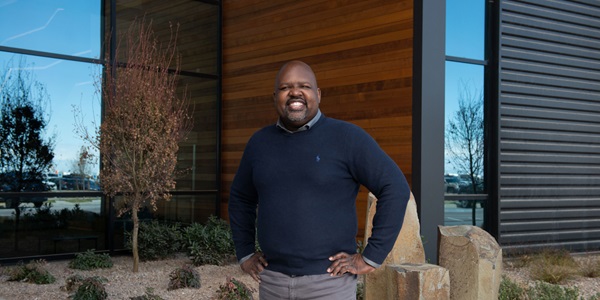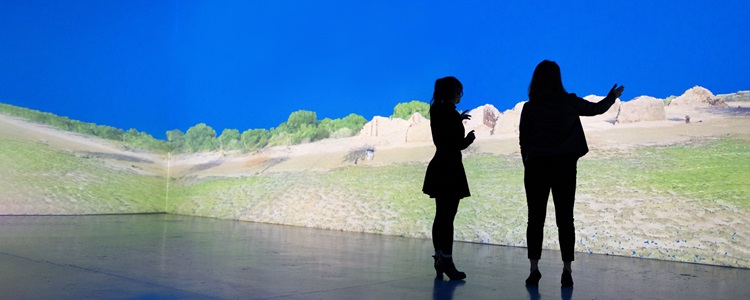When it comes to solving the mysteries of the universe, Northrop Grumman has pioneered groundbreaking technologies from the very beginning.
Chasing the Ionosphere

By Stephanie Bright and Brooks McKinney
Sometimes solutions to the most complex of challenges in space present themselves in unexpected places... like the middle of Midwest farmland.
Before the COVID-19 pandemic hit the United States, Jim Jones, a Northrop Grumman technical fellow based in Nebraska, had been modeling the ionosphere for a Defense Advanced Research Projects Agency (DARPA) program, focused on producing a next-generation battlefield radio for U.S. service members who direct close air support for ground forces. He theorized that high frequency (HF) radio waves could be "bounced" off the ionosphere at certain frequencies using a technique called Near-Vertical Incidence Skywave (NVIS) and remain stable for a sufficient period of time to send messages. In theory, this would allow U.S. Armed Forces to send and receive radio communications in a region with complex terrain, such as mountains or cities.
DARPA soon approached Northrop Grumman to build a set of HF transmitters to prove one of Jim’s theories. But DARPA’s call came during 2020, in the midst of pandemic constraints. Jim and his colleague, fellow atmospheric scientist Tim Nobis, had to get creative. Both are specialists in predictive science; they develop numerical models and simulations of the atmosphere and use those models to predict how well communication signals will propagate under various conditions of temperature, pressure and humidity.
They also share another title, farm owners, which would prove to be the perfect opportunity for experimenting.
WFF: ‘Work From Farm’
HF radio waves have a wavelength of about 100 meters, so Jim’s NVIS transmitters would have to be spaced at least 100 miles apart for the experiment to work. Coincidentally, that’s the exact distance between Jim and Tim’s farms, which are both located within 80-miles of Omaha, Nebraska.
“We decided to just go for it. It really took the whole ‘working from home’ to another level,” said Jim.
Jim and Brian Beatty, another Northrop Grumman colleague, designed and produced four HF transmitters for the experiments in Jim's barn. Starting with commercial software-defined radios, they wrote custom software to create the waveforms and built various customized HF antennas.
When their first test day arrived, Jim and Tim set up two HF transmitters and a variety of antennas at their respective farms before dawn. Then, for the next few hours, they would "chase the ionosphere," sending different types of communication packets back and forth between their farms.
"We always started off at a very low frequency, typically about 3 MHz," said Jim. "As the sun rose, however, it would agitate the atmosphere, creating static at low frequencies. But if we raised the frequency too much, the signal would go straight through the ionosphere and not bend back toward the earth."
They continued this process for all of summer and fall of 2021. The farm-based testing produced valuable insights for DARPA: it demonstrated that changes in the ionosphere, which affect the quality of communications, occur in a matter of seconds, not minutes. According to Jim, it also showed that it's possible to do beam forming at HF.

The Future Frontier
Northrop Grumman’s company culture encourages and supports innovation and curiosity and gives employees the space to think outside the box (or office) in order to solve our customers’ hardest problems.
"The pandemic got us out of the building, got us thinking about alternative ways to get work done and led to some powerful new concepts for DARPA," said Jim.
Today, Jim and Tim plan to continue characterizing the atmosphere and honing their skills in predictive science using their rural properties. They plan to expand the scope of their signal experiments by adding their colleague Braedi Wickard and her farm to their testing configurations to create a testing triangle. Braedi, who lives near Tim in Iowa, said this would allow them to test multiple waveforms and antenna designs at different frequencies under various atmospheric conditions.
“Our experiments on the farm really bring me back to what I love about science and research,” said Jim. “I literally jumped up and down when our DARPA experiment worked, and I can’t wait to discover more. These are the moments when I can’t believe I get paid for this.”
Learn more about our people and life at Northrop Grumman, and check out our career opportunities to see how you can help define possible.
Inset shot: Pictured here during testing at his farm in Nebraska, Jim specializes in predictive science.


